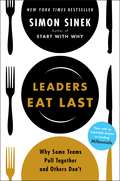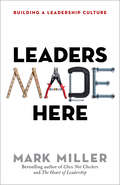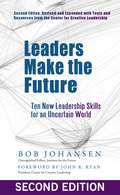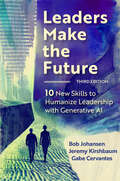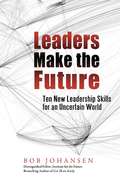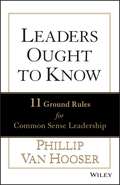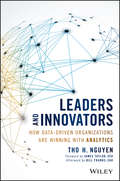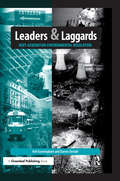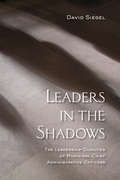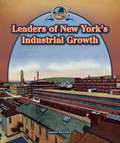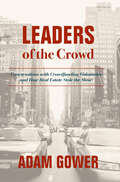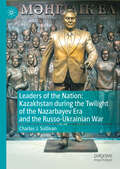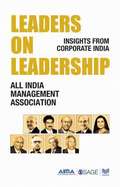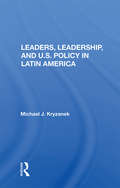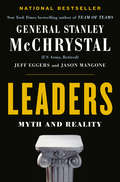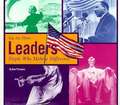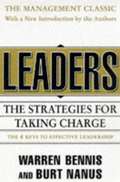- Table View
- List View
Leaders Eat Last: Why Some Teams Pull Together and Others Don't
by Simon SinekThe New York Times bestseller by the acclaimed, bestselling author of Start With Why and Together is Better. Now with a new chapter on leading millennials, based on Simon Sinek's viral video "The Millennial Question" (150+ million views).Imagine a world where almost everyone wakes up inspired to go to work, feels trusted and valued during the day, then returns home feeling fulfilled. This is not a crazy, idealized notion. Today, in many successful organizations, great leaders create environments in which people naturally work together to do remarkable things. In his work with organizations around the world, Simon Sinek noticed that some teams trust each other so deeply that they would literally put their lives on the line for each other. Other teams, no matter what incentives are offered, are doomed to infighting, fragmentation and failure. Why?The answer became clear during a conversation with a Marine Corps general. "Officers eat last," he said. Sinek watched as the most junior Marines ate first while the most senior Marines took their place at the back of the line. What's symbolic in the chow hall is deadly serious on the battlefield: Great leaders sacrifice their own comfort--even their own survival--for the good of those in their care. Too many workplaces are driven by cynicism, paranoia, and self-interest. But the best ones foster trust and cooperation because their leaders build what Sinek calls a "Circle of Safety" that separates the security inside the team from the challenges outside.Sinek illustrates his ideas with fascinating true stories that range from the military to big business, from government to investment banking.
Leaders Made Here: Building a Leadership Culture (The High Performance Series #2)
by Mark MillerLeaders Made HereGreat leaders create great organizations. However, a scarcity of leaders today means a shortfall in performance tomorrow. Don't gamble with your company's future!You don't need to hope that leaders emerge from the ranks or that search firms can find the leaders you need in a timely fashion. Hope is not a strategy! You can build an organizational culture that will ensure your leadership pipeline is full and flowing. Bestselling author and Chick-fil-A executive Mark Miller describes how to nurture leaders throughout the organization, from the front lines to the executive ranks. Leaders Made Here outlines a clear and replicable approach to creating the leadership bench every organization needs. To bring his ideas to life, Miller uses the story of Blake, a new CEO, and Charles and old friend and colleague, as they search for the best practices from around the world to ensure a continuous supply of their most precious asset – leaders. Blake and his team then translate their findings into a practical plan that any organization can use to create a leadership culture, sustained competitive advantage, and long-term success.
Leaders Make the Future
by Robert JohansenIdentifies surprising new leadership skills vital to coping with today's uncertain, rapidly changing world Includes exercises and assessments for developing and applying these skills A fully updated and revised edition of a book adopted by leaders at Procter & Gamble, Target, McDonalds, Electronic Arts, UPS, Kraft, and many other companies We are in a time of disruptive change--traditional leadership skills won't be enough, noted futurist Bob Johansen argues. Drawing on the latest ten-year forecast from the Institute for the Future--the only futures think tank ever to outlive its forecasts--this powerful book explores the external forces that are shaking the foundations of leadership and unveils ten critical new skills that will be required in the future, skills that you can learn. In this second edition, Johansen is joined by the prestigious Center for Creative Leadership. CCL's contributions help readers understand the new leadership skills by linking them to existing skills, and they provide analytics and exercises so readers can develop these new skills. This edition has been updated throughout, with a new ten-year forecast and new examples, and incorporates the lessons Johansen has learned about applying the new leadership skills in the three years since the first edition appeared. In addition, Johansen deals with two new forces that are shaping the future. The first is the "digital natives"--people fifteen years and younger who have grown up in a completely digital world. The second is cloud-based supercomputing, which will enable new forms of connection, collaboration, and commerce and will greatly facilitate reciprocity-based innovation--giving away to get more--which Johansen sees as the biggest innovation opportunity in history. "Whether you're a seasoned leader or a first-time manager, Leaders Make the Future will help bring clarity to a VUCA [volatile, uncertain, complex, and ambiguous] world. It has become a cornerstone to our leadership training efforts and has proven to be very insightful and useful." --Donald J. Hall Jr., President and CEO, Hallmark Cards, Inc.
Leaders Make the Future, Third Edition: Ten New Skills to Humanize Leadership with Generative AI
by Bob Johansen Jeremy Kirshbaum Gabe CervantesIn a world of chaos, how can generative AI help leaders lead?Over the next decade, all leaders will be augmented with some form of generative artificial intelligence, or GenAI. For the best leaders, this will mean dramatic improvement. For mediocre leaders, this will mean persistent confusion, distraction, and pretense. With futureback thinking—looking ten years ahead, then planning backward from future to next to now—this third edition of Leaders Make the Future shows how people can improve their leadership skills while expanding their human perspective.Now 75 percent revised and expanded with resources from the Institute for the Future, this new edition is organized around ten future leadership skills:Augmented futureback curiosityAugmented clarityAugmented dilemma flippingAugmented bio-engagingAugmented immersive learningAugmented depolarizingAugmented commons creatingAugmented smart mob swarmingAugmented strength with humilityHuman calmingAI-augmented leadership will be key for any organization to tackle the uncertainty of the future. And by incorporating practical methodologies, ethical guidelines, and innovative leadership practices, this book will help leaders develop their clarity and moderate their certainty.
Leaders Make the Future: Ten New Leadership Skills for an Uncertain World
by Bob JohansenLeaders Make the Future will build on the core themes of Get There Early. Get There Early is a foundational book that introduces the Foresight to Insight to Action Cycle, with many examples. It is a complex book, with many ideas.
Leaders Manage Climate: Creating Strategic Speed in Everyday Operations Through an Engaged, Motivated Workforce
by Henry M. Frechette Edwin H. Boswell Jocelyn R. DavisIf there's such a thing as a magic wand to create strategic speed in everyday execution, managing workplace climate is it. Defined as what it feels like to work in a particular organization, climate is something leaders have tremendous control over. And while other leadership practices, such as affirming strategies and driving initiatives, help increase strategic speed when you're dealing with a major initiative or large project, managing climate does double duty-it increases the speed not only of strategic initiatives but also of your organization's everyday work. In this chapter, the authors, all of whom are executives at The Forum, a global consulting firm, use compelling examples from satellite television provider Tata Sky, global real estate giant Archstone, and medical device supplier Abbott Vascular China to illustrate how the six dimensions of climate-clarity, standards, commitment, responsibility, recognition, and teamwork-interact to powerful effect on an organization's ability to execute, and execute fast. The chapter concludes with a brief self-assessment to help you size up your personal effectiveness at managing workplace climate. This chapter was originally published as Chapter 5 of "Strategic Speed: Mobilize People, Accelerate Execution."
Leaders Ought to Know
by Phillip Van HooserGlobally acclaimed leadership development expert, Phillip Van Hooser, teaches the ground rules of common sense leadershipThere are just some things every leader ought to know - like how to earn an employee's respect, how to be truthful and be taken seriously as a leader. Leaders should also realize and recognize the negative habits and counter-productive behaviors that can be their downfall. Certain to be one of your top books on personal leadership development, Leaders Ought To Know will get all leaders -- new leaders, mid-level or executive managers -- familiar with the ground rules of leadership. Kick start your company's leadership development program with this common sense guide from Phillip Van Hooser, a top leadership development expert -- learn how to do more of the right things while avoiding the common leadership mistakes that trip up so many.
Leaders Who Make a Difference: Day 1
by Joseph L. Bower Sonja Ellingson HoutSam Palmisano became CEO of IBM in 2002. He dramatically energized the organization through portfolio changes and a values driven approach to managing the company.
Leaders and Innovators: How Data-Driven Organizations Are Winning with Analytics
by James Taylor Bill Franks Tho H. NguyenAn integrated, strategic approach to higher-value analytics Leaders and Innovators: How Data-Driven Organizations Are Winning with Analytics shows how businesses leverage enterprise analytics to gain strategic insights for profitability and growth. The key factor is integrated, end-to-end capabilities that encompass data management and analytics from a business and IT perspective; with analytics running inside a database where the data reside, everyday analytical processes become streamlined and more efficient. This book shows you what analytics is, what it can do, and how you can integrate old and new technologies to get more out of your data. Case studies and examples illustrate real-world scenarios in which an optimized analytics system revolutionized an organization's business. Using in-database and in-memory analytics along with Hadoop, you'll be equipped to improve performance while reducing processing time from days or weeks to hours or minutes. This more strategic approach uncovers the opportunities hidden in your data, and the detailed guidance to optimal data management allows you to break through even the biggest data challenges. With data coming in from every angle in a constant stream, there has never been a greater need for proactive and agile strategies to overcome these struggles in a volatile and competitive economy. This book provides clear guidance and an integrated strategy for organizations seeking greater value from their data and becoming leaders and innovators in the industry. Streamline analytics processes and daily tasks Integrate traditional tools with new and modern technologies Evolve from tactical to strategic behavior Explore new analytics methods and applications The depth and breadth of analytics capabilities, technologies, and potential makes it a bottomless well of insight. But too many organizations falter at implementation--too much, not enough, or the right amount in the wrong way all fail to deliver what an optimized and integrated system could. Leaders and Innovators: How Data-Driven Organizations Are Winning with Analytics shows you how to create the system your organization needs to dramatically improve performance, increase profitability, and drive innovation at all levels for the present and future.
Leaders and Laggards: Next-Generation Environmental Regulation
by Darren Sinclair Neil GunninghamConsensus is growing internationally that traditional command-and-control approaches to environmental regulation have borne much of their low-hanging fruit. Yet it is far from clear what should complement or replace them. Regulatory agencies and policy-makers are struggling with a lack of information about regulatory reform, about what works and what doesn't, and about how best to harness the resources of both government and non-government stakeholders. Progress is being impeded unnecessarily by a lack of shared knowledge of how similar agencies elsewhere are meeting similar challenges and by a lack of data on the success or otherwise of existing initiatives. Despite recent and valuable attempts to deal with such problems in the European Union and North America, these remain islands of wisdom in a sea of ignorance. For example, when it comes to dealing with small and medium-sized enterprises, very little is known, and what is known is not effectively distilled and disseminated. Much the same could be said about the roles of third parties, commercial and non-commercial, as surrogate regulators, and more broadly of many current initiatives to reconfigure the regulatory state. Based on the authors' work for the OECD, Victorian Environmental Protection Authority and the Western Australian Department of Environment Protection, Leaders and Laggards addresses these problems by identifying innovative regulatory best practice internationally in a number of specific contexts, evaluating empirically the effectiveness of regulatory reform and providing policy prescriptions that would better enable agencies to fulfil their regulatory missions. Focusing primarily on the differing requirements for both corporations and small and medium-sized enterprises in North America and Europe, the book aims to complement existing initiatives and to expand knowledge of regulatory reform by showing: how existing experience can best be put to practical use "on the ground"; by drawing lessons from experiments in innovative regulation internationally; by reporting and extrapolating on original case studies; and by advancing understanding on which instruments and strategies are likely to be of most value and why. The authors argue that the development of theory has outstripped its application. In essence, Leaders and Laggards aims to ground a myriad of theory on the reinvention of environmental regulation into practice. The book will be essential reading for environmental policy-makers, regulatory and other government officials responsible for policy design and implementation, academics and postgraduate students in environmental management, environmental law and environmental policy, and a more general readership within environmental policy and management studies. It will also be of interest to those in industry, such as environmental managers and corporate strategists, who are considering the use of more innovative environmental and regulatory strategies, and to environmental NGOs.
Leaders as Expert Performers: Practice Can Trump Talent
by Robert J. ThomasNo amount of native talent can prepare a leader for the infinite variety of circumstances she will face or the challenges she must surmount. Like accomplished performers in sports, music, or the arts, great leaders practice as strenuously as they perform and seize opportunities not only to learn by doing, but to learn while doing.
Leaders at All Levels
by Ram CharanLearn how top companies solve the problem of leadership succession from corporate America's leading consultant.A serious crisis looms in American management today. More and more CEOs are failing; there remains an acute shortage of capable replacements. The true dilemma in leadership is the stagnant state of corporate leadership development. Because companies fail to hone their unit managers' leadership abilities, they are never able to fill their succession pipelines. With unit managers stagnating, companies have difficulty executing at every level, compounding the crisis. In I>Leaders at All Levels, bestselling author Ram Charan shows how top companies approach leadership development as a core competency, recognizing that an adaptable leadership pool is a competitive advantage, and focusing their attention on bringing out the best in the leaders they have.Charan reveals exactly what's wrong with corporate leadership development and tells how to make it right. He explains the concept of a leadership "gene pool" and shows how companies can discover just what "DNA" they need to succeed. He also details how to uncover the hidden leaders in a company, when and where to bring in fresh talent, how to coach, measure, and reward leadership, and much more. For CEOs, directors, and anyone involved in leadership development, Leaders at All Levels is an eye-opening guide on how to get succession right.
Leaders for Health Care: What You Can Learn From Them about Leading in the Knowledge Economy
by Michael MaccobyHealthcare organizations are prime examples of knowledge workplaces. The best of these - the Mayo Clinic, Intermountain Health Care, and others - have benefited from interactive leaders. Both businesses and non-profits can learn from their experiences in dealing with resistance to change and creating collaborative learning organizations.
Leaders for Knowledge Work: Types of Organizational Leaders
by Michael MaccobyIn knowledge-creating companies, we find three kinds of leaders who have to work together: strategic visionaries, operational implementers, and bridge-builders. This chapter describes the different types of organizational leaders required for knowledge work and shows the role of social character in both facilitating and resisting the changes needed to make organizations more effective and efficient.
Leaders for Learning: What You Can Learn From Education Leaders about Leading in the Knowledge Economy
by Michael MaccobyEducation is not just about knowledge; it's also about developing the social character that prepares people to succeed in society. The leaders of Knowledge is Power Program (KIPP) and Nuestros Peque os Hermanos (NHP) are showing that it's possible to help some of the most disadvantaged children learn and develop the social character needed to succeed in the world of knowledge work. In this chapter, the author examines these exceptional education leaders and extracts valuable lessons for leaders of knowledge workers.
Leaders for Tomorrow: Challenges for Military Leadership in the Age of Asymmetric Warfare (Advanced Sciences and Technologies for Security Applications)
by Marina Nuciari Eraldo OlivettaSince the end of bipolarism, the concept of asymmetric warfare, and of asymmetric conflict in general, has been increasingly applied with regard to armed forces activities and tasks. This book presents the findings of comparative empirical research conducted in selected military units by a group of distinguished experts on military organization, who hail from the eight participating countries: Bulgaria, Cameroon, Denmark, Finland, Italy, Lithuania, the Philippines and Spain.It discusses remarks made by military leaders with extensive experience in the field regarding current doctrines on military leadership and their applicability in the field, as well as proposals and suggestions for new directions.“It is a complex relation, always based on respect and politeness, but often with mismatched interests.” (Army Colonel).“It makes you realize that there is a cultural gap. You must firstly understand who you are going to relate to, and the culture of these people, and then try to establish a certain kind of relationship. Often the platoon commander states his objective and must try to establish a relationship, contact with the village chief.” (Army Lieutenant, Platoon Commander).“[In Afghanistan] We had meals with the locals, sometimes the food didn’t taste good, but you had to eat it if you wanted to be welcomed back again” (Army Captain, Company Commander).These are just some of the many voices stemming from the ground in diverse international asymmetric conflict theatres (in Iraq, in Kosovo, in Afghanistan…), comments by military officers, commanders at different hierarchical levels, asked to reflect on their experiences as military leaders in crisis response operations.Military professionals, and military leaders in particular, perceive themselves as facing ambiguous situations that require an update in their professional training, and new skills to confront unexpected and unpredictable factors. Drawing on lived experiences, the book offers insights into what a new kind of leadership means when leaders have to cope with diverse and unclear missions. It also addresses leadership styles and behaviours, as well as individual adaptive behaviours on the part of military leaders, with special reference to middle and middle-high level ranks, such as captains, majors and colonels.Given its scope, the book will appeal not only to military professionals and military affairs scholars and experts, but also to readers interested in gaining a better understanding of the challenges that international expeditionary units are facing in crisis areas around the globe.
Leaders in the Shadows
by David SiegelIn most municipalities across Canada, the top public servant is the chief administrative officer (CAO) or city manager. Compared to elected politicians such as the mayor and the council, the work of a CAO is often overlooked and not well understood. In Leaders in the Shadows, David Siegel brings the CAO into the limelight, examining the leadership qualities of effective municipal managers.Using the examples of five exceptional CAOs who have worked in municipalities of varying sizes across Canada, Siegel identifies the leadership traits, skills, and behaviours which have made them successful. Interweaving the stories of his subjects with insights drawn from leadership theory, Siegel offers an engrossing account of how CAOs must lead "up, down, and out" in order to succeed. Offering well-rounded accounts of the challenges and opportunities faced by public servants at the municipal level, Leaders in the Shadows is a valuable resource for academics and practitioners alike.
Leaders of New York's Industrial Growth (Spotlight on New York)
by James BernardIntroduces major developments in the economic history of New York and describes the growth of railroads, the Brooklyn Bridge, glassmaking, oil, electricity, finance, and other industries and the accomplishments of some of the people involved.
Leaders of the Crowd: Conversations With Crowd Funding Visionaries And How Real Estate Stole The Show
by Adam GowerCrowdfunding is nothing new. In fact, America was built and financed by crowdfunding. But in 1933 Congress passed the Securities Act, which shut the door on this most democratic means of raising capital and spreading wealth. In 2012, enjoying broad bipartisan support, congress threw the doors open again, passing the JOBS Act (Jumpstart Our Business Startups). Its intent was to stimulate growth of small businesses and startups, but an unexpected consequence of the Act was that the biggest beneficiary has been the real estate industry. <p><p> Researching the origins of the JOBS Act, Dr. Adam Gower conducted a series of conversations with the people who lobbied for and wrote the laws that became the Act. What he discovered was that at no time had anyone thought that the real estate industry was a relevant constituency. Perplexed by this disconnect between what had been intended and what had happened, he talked to those who had been the very first real estate people to utilize the JOBS Act. These pioneers, all moving on parallel tracks, seeded the biggest, most transformational change to the real estate industry in history. <p> This book uncovers these conversations with the people who created the laws and those who connected the dots to real estate. It weaves a thread through the labyrinthine processes of government, chronicling how the Act was conceived, formed, and ultimately signed into law, and it reveals how the visionaries who have revolutionized real estate capital formation embarked on their missions to change their industry forever. <p> Learn how the JOBS Act, never expected to benefit real estate, has transformed the industry, changing the way capital is raised and syndications are formed forever and how an unintended consequence is helping almost everyone in America invest in real estate like never before.
Leaders of the Nation: Kazakhstan during the Twilight of the Nazarbayev Era and the Russo-Ukrainian War
by Charles J. SullivanThis book provides an overview of the major developments in Kazakhstan over the past decade. In analyzing a series of challenges (such as the need on behalf of the current Kazakh president – Kassym-Jomart Tokayev – to restore legitimacy in the government in the aftermath of "Bloody January" as well as Astana’s managing of relations with Russia, China, and the West), this book offers readers a timely understanding concerning how power has been wielded, mishandled, and reasserted in this country. This book explores the achievements of Kazakhstan’s modernization drive, the government’s prolonged initial political transition, the rise of a local civil society, the events of January 2022, and Kazakhstan’s relations with Russia and the West. Written by a political scientist who previously worked at the country’s flagship university, Leaders of the Nation: Kazakhstan during the Twilight of the Nazarbayev Era and the Russo-Ukrainian War outlines why Kazakhstan warrants our earnest attention.
Leaders on Leadership
by All India AssociationWho can tell what it really takes to be an effective leader today? The most successful CEOs can! From inside the minds of top CEOs of India, here are invaluable lessons on the most significant aspects of leadership. This compilation of short personal narratives by iconic business leaders tells us how even the most accomplished leaders had to discover their leadership calling and develop their traits with conscious initiative and practice. Most leadership literature is too formal, too didactic. Leadership, however, is not and will never be a "one-size-fits-all" concept. This book is born out of the need for learning the art of leadership from the unique examples of the most successful leaders. With contributions from celebrated business leaders like Raghav Bahl, Kumar Mangalam Birla, Tarun Das, Adi Godrej, Chanda Kochhar, R.A. Mashelkar, N.R. Narayana Murthy, Deepak Parekh, and M.V. Subbiah, this book leads the reader to appreciate the journey of the these leaders from being undistinguished individuals to becoming celebrated corporate luminaries; to draw inspiration and learn from their struggles and achievements.
Leaders, Leadership, And U.s. Policy In Latin America
by Michael J. KryzanekThis book focuses on the future of Latin American leaders and the relationship of these leaders to the United States. It examines the ways in which the critical interaction between individual leaders and the U.S. policy community affects the substance and direction of hemispheric relations.
Leaders: Myth and Reality
by Stanley McChrystal Jeff Eggers Jay MangoneLeadership is not what you think it is--and it never was.Stan McChrystal served for thirty-four years in the US Army, rising from a second lieutenant in the 82nd Airborne Division to a four-star general, in command of all American and coalition forces in Afghanistan. During those years he worked with countless leaders, at every level of effectiveness, and pondered an ancient question: “What makes a leader great?” He came to realize that there is no simple answer. In this follow-up to his bestsellers My Share of the Task and Team of Teams, McChrystal profiles thirteen famous leaders from a wide range of eras and fields—from corporate CEOs to politicians and revolutionaries. He uses their stories to explore how leadership works in practice and to challenge the myths that complicate our thinking about this critical topic. With Plutarch’s Lives as his model, McChrystal looks at paired sets of leaders who followed unconventional paths to success. For instance. . .· Walt Disney and Coco Chanel built empires in very different ways. Both had public personas that sharply contrasted with how they lived in private. · Maximilien Robespierre helped shape the French Revolution in the eighteenth century; Abu Musab al-Zarqawi led the jihadist insurgency in Iraq in the twenty-first. We can draw surprising lessons from them about motivation and persuasion. · Both Boss Tweed in nineteenth-century New York and Margaret Thatcher in twentieth-century Britain followed unlikely roads to the top of powerful institutions. · Martin Luther and his future namesake Martin Luther King Jr., both local clergymen, emerged from modest backgrounds to lead world-changing movements. Finally, McChrystal explores how his former hero, General Robert E. Lee, could seemingly do everything right in his military career and yet lead the Confederate Army to a devastating defeat in the service of an immoral cause. Leaders will help you take stock of your own leadership, whether you’re part of a small team or responsible for an entire nation.
Leaders: People Who Make a Difference
by Gare ThompsonThis high-impact picture essay series conveys a vivid sense of historical perspective through the panoramic use of photos and lively, engaging text. Crosscurricular in approach, this series will enrich social studies classes by bringing together information on the arts, literature, political history, and occupations. This book brings the reader into close contact with the leader, who have molded the world we live in.
Leaders: Strategies for Taking Charge (Second Edition)
by Warren Bennis Burt NanusA book about leadership in corporate America. The authors discuss four essential concepts for effective management.
